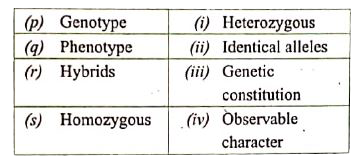In a test cross involving F1dihybrid flies, more parental type offspring were produced than the recombination type off spring. This indicatesSolution in Tamil
The two genes are located on two different chromosomes.
Chromosomes failed to separate during meiosis
The two genes are linked and present on the same chromosomes
Both of the characters are controlled by more than one gene.
The correct Answer is:C
Step by step video, text & image solution for In a test cross involving F_(1)dihybrid flies, more parental type offspring were produced than the recombination type off spring. This indicates by Biology experts to help you in doubts & scoring excellent marks in Class 12 exams.
Updated on:21/07/2023Topper's Solved these Questions
- CLASSICAL GENETICS BOOK - PREMIERS PUBLISHERSCHAPTER - CLASSICAL GENETICS EXERCISE - OTHER IMPORTANT QUESTIONS & ANSWERS (1. CHOOSE THE CORRECT ANSWERS: 1 MARK)
25 Videos
- CLASSICAL GENETICS BOOK - PREMIERS PUBLISHERSCHAPTER - CLASSICAL GENETICS EXERCISE - OTHER IMPORTANT QUESTIONS & ANSWERS (II. ANSWER THE FOLLOWING:)
15 Videos
- BIODIVERSITY AND ITS CONSERVATIONBOOK - PREMIERS PUBLISHERSCHAPTER - BIODIVERSITY AND ITS CONSERVATIONEXERCISE - OTHER IMPORTANT QUESTIONS & ANSWERS (Answer the followlng)
22 Videos
- ECONOMICALLY USEFUL PLANTS AND ENTREPRENEURIAL BOTANY BOOK - PREMIERS PUBLISHERSCHAPTER - ECONOMICALLY USEFUL PLANTS AND ENTREPRENEURIAL BOTANY EXERCISE - OTHER IMPORTANT QUESTION & ANSWERS (ANSWER THE FOLLOWING)
27 Videos
Similar Questions
Match the following:

View SolutionDefine heredity.
View SolutionDefine biodiversity.
View SolutionWhat is meant by pseudo-cereal?
View SolutionIn a testcross involving "F"_(1) dihybrid flies, more parental-type offspring were produced than the recombinant-type offspring. This indicates:
View SolutionIn a test cross involving F1 dihybrid flies, more parental-type offspring were produced than the recombinant type offspring. This indicates
View SolutionIn a testcross involving F_(1) dihybrid flies, more parental-type offsping were produces than the recombinant-type offspring. This indicates
View SolutionIn a test cross involving F_(1) dihybrid flies, more parental type offspring were produced than the recombination type off spring. This indicates
View SolutionIn a test cross involving F1dihybrid flies, more parental type offspring were produced than the recombination type off spring. This indicates
View Solutionपरीक्षार्थ प्रसंकरण में , जिसमें F1- द्विसंकर मक्खियाँ शामिल थीं, में पुनर्योगज प्रकार की सन्ततियों की तुलना में जनक प्रकार की सन्ततियाँ अधिक उत्पन्न हुई। इनमें संकेतक मिलते हैं, कि
View SolutionIn a test cross involving F1 dihybrid flies, more parental-type offspring were produced than the recombinant type offspring. This indicates
View SolutionIn a testcross involving F1 dihybrid flies, more parental-type offsping were produces than the recombinant-type offspring. This indicates
View SolutionIn a testcross involving F1 dihybrid flies, more parental-type offspring were produced than the recombinant-type offspring. This indicates:
View Solutionपरीक्षार्थ प्रसंकरण में , जिसमें F1- द्विसंकर मक्खियाँ शामिल थीं, में पुनर्योगज प्रकार की सन्ततियों की तुलना में जनक प्रकार की सन्ततियाँ अधिक उत्पन्न हुई। इनमें संकेतक मिलते हैं, कि
View SolutionIn a test cross involving F1 dihybrid flies, more parental-type offspring were produced than the recombinant type offspring. This indicates
View SolutionIn a testcross involving "F"1 dihybrid flies, more parental-type offspring were produced than the recombinant-type offspring. This indicates:
View Solution
